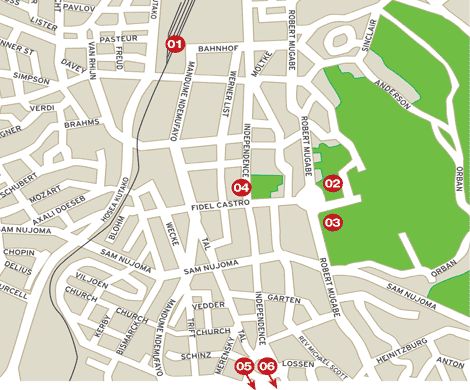Just over a century ago, Windhoek was a crossroads in the desert, but today the Namibian capital is a bustling urban centre with elegant churches and green parks. Felicity Cousins takes a stroll

1. Railway Station
If you arrive in Windhoek by train, you haven't got far to go for your first stop on our tour. The railway station on Bahnhof Street is used mainly for the mining and fishing trade between Namibia and South Africa, though there is now a Desert Express with fast links to the north of the country. The little station was built by the Germans in 1903, and is 1,652m above sea level. There is a museum here, open Monday to Saturday, costing around NB$20 (£1.50). Old trains surround the station, but if you go inside there are photographs on the wall, which show exactly how fast Windhoek's development has been over the last 100 years - from a crossroads in the desert, to a town 25 years later, then a city as it is today.
2. The German Church and The Ink Palace
From the station head east along Bahnhof Street and right along Robert Mugabe Avenue until you reach the German Church, which was built in 1907. Namibia was a German colony from 1884 until 1919, and many of the buildings in Windhoek were built during the German era. It is still a working church today and inside is a memorial to the Germans who died in the conflict with Namibia's Herero tribe. From the church, you can look up the hill to the Tintenpalast (or Ink Palace). This is the home of the Namibian National Council and National Assembly, and was inaugurated in 1913. The National Assembly consists of 80 MPs who send laws to the National Council of 32 people, who represent the people and decide if the new laws are fair.
3. Alte Feste
Across the road from the church is a statue commemorating the Herero who died in the Hottentot uprising of 1903-1908. Behind it stands the Alte Feste (or Old Fort), one of the oldest buildings in Windhoek, dating back to 1890. It was built to preserve the peace between the Namas and Hereros, two fighting tribes, and has been used as a military headquarters and a hostel. These days it is a national monument and museum. Inside, the main part of the museum concentrates on the independence, with displays of ballot papers, but at the back is a section on the history of Windhoek, while outside there is a display of military machines. Open Mon-Sat, free entry.
4. Independence Avenue and Cafe Zoo
From the church, head down Fidel Castro Street until you hit Independence Avenue. This is a pleasant street to take a stroll along, with shopping centres and Zoo Park, which has local market stores set up regularly. It is also home to the popular and shaded Zoo Cafe, a good place to stop and watch the activities on the street and in the park. Continue south down Independence Avenue and turn right onto Sam Nujoma Street. Across the road you will be able to see the Old Brewery, which is now the Craft Centre, with stalls selling African arts and crafts, photographs and music, amidst the old brewing machinery. It is designed for tourists and therefore everything has a "tourist price", but if you're looking for souvenirs and don't have much time to haggle, then this is the easy (if pricier) option. There's a coffee shop here too.
5. Three castles
For a good view over the city, head for Heinitzburg Street, on what is known as Luxury Hill, just south of the city centre. This area contains the most desirable real estate in Windhoek - all the houses are individually designed (some with more taste than others), and all have prime views over the city. The Germans built three castles here: Schwerinsburg, Sanderburg, and Heinitzburg. There is a good view from the latter, which became a hotel in 1966 and is well known in the city for its gourmet restaurant - you can see right over the city centre to the mountains beyond.
6. Heroes' Acre
It's worth making the trip around 10km south of Windhoek to Heroes' Acre, which was built after Namibia's 10th year of independence. It was actually built by the North Koreans - as was an extremely expensive and controversial house for the president, with concrete elephants in the garden and a rather terrifying statue of an eagle by the door. Heroes' Acre was inaugurated in 2003 to commemorate the people's struggle and to remember the heroes of Namibia. The 174 graves are in neat gravel tiers, rising up from the eternal flame to an 8m statue of an unknown soldier and a 30m obelisk. Currently, there are not many heroes buried here, but it is interesting to see the ones that are, with titles, such as Gertrud Kandango (Freedom Fighter). Behind the obelisk is a mural of the Namibian struggle from slavery to freedom. It is eerily quiet at the top, with only the sound of the wind blowing and a view of birds of prey circling above the city.
Felicity had a guided tour with Omahuka Transfers and Tours. For further details, go to namibiatourism.com.na.








